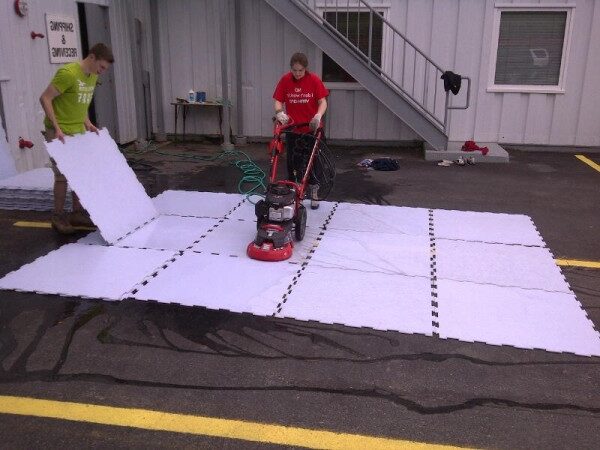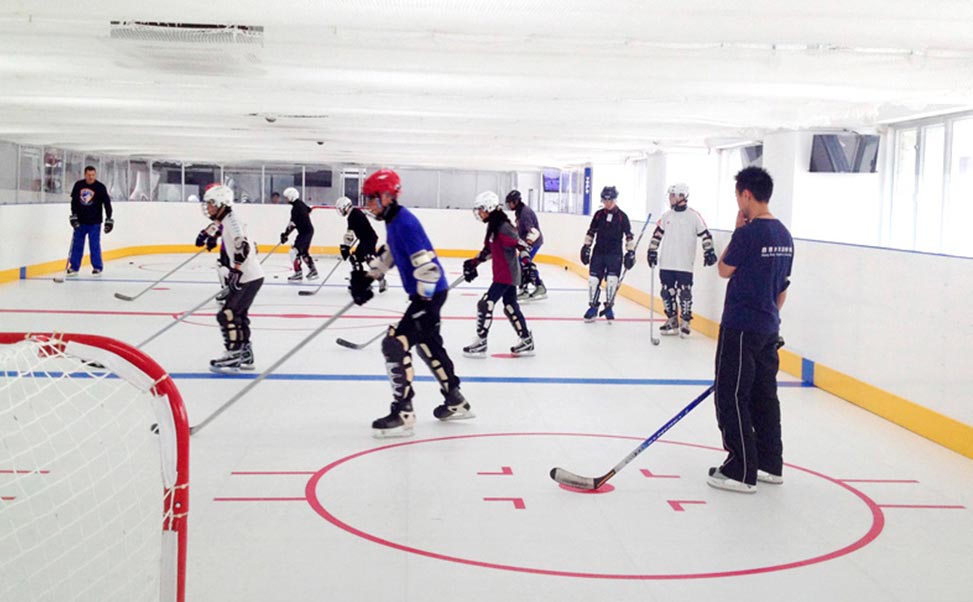The world of at-home hockey training products is incredibly vast. You may have been a little surprised when you started going down this rabbit hole when you discovered just how many things that you have to choose from. One of the hardest choices to make is trying to determine which is better, slick tiles vs synthetic ice. These two products have a lot of similarities and a lot of differences that mean that they’re good for different situations. Most people would be able to benefit from practicing on either, but which one is going to be better for your home?
At the end of the day, we probably won’t be able to definitively tell you which is objectively the better option is. That is because there’s no real objective best option here. Both options are fantastic options for getting in some good hockey training. Really, the best way to know what’s best for you is to think about what your needs are and how much space you have to throw at this project. What we hope to do today is give you an outline of both products so you can choose for yourself which one is going to be able to suit your needs as effectively as possible.
Table of Contents
Learning About Synthetic Ice
Out of the two products we’ll be talking about today, synthetic ice is definitely the one with the more interesting history. The first even synthetic ice made without the use of water actually predates the first artificially frozen ice by a few decades. It was created in England in the late 1800s, and it was definitely created before its time considering the inventors didn’t make money on a product that now nets millions of dollars per year. The exact materials that have been used by people that make synthetic ice have changed a lot over time.
The oldest synthetic ice didn’t have a very good glide factor at all, and neither did the synthetic ice that was used in the revival of the product. Both of these types of synthetic ice needed to be lubricated in order for them to be usable at all. In the modern-day, the synthetic ice that is used has a much higher glide factor, meaning that you either won’t need to lubricate the tiles at all or you won’t need to use lubrication as often and you’ll still get the same glide factor. That’s great because it means that you’ll need to spend less time doing maintenance, freeing you up for more training time.
Synthetic ice is designed to be used with your regular ice skates, which means that it provides the ideal space for getting practice hitting the puck while skating around. You could do any drill on synthetic ice that you would be able to on real ice. If you wanted to, and had the space needed, you could even host little scrimmage matches between friends on the synthetic ice. That makes this option a great one for people that have enough space to support it. Really, the amount of dedicated space that you need for the synthetic ice is the biggest drawback.
Synthetic ice is weather-proof, so if you wanted to you could easily set it up in your backyard and forget about it until it’s time to use it. You might have to take it down when you have guests over because of just how slick synthetic ice is. For that same reason, we couldn’t recommend keeping it in your garage if you plan on parking there or if your garage is generally a high foot traffic area. You could theoretically cover it with a tarp or something like that to help mitigate the slippery surface, but generally it’s best just to keep it away from where people could walk on it too much.
The More You Know About Dryland Hockey Tiles
People call slick tiles a lot of different names. Hockey flooring, hockey tiles, dryland hockey tiles, the list goes on. All of these are referring to the same thing, which is essentially hockey flooring that isn’t quite as slick as synthetic ice that can still be used as a solution to home hockey training. These tiles are a lot different than synthetic ice, but they do also have a lot of similarities by nature. Let’s start off just by covering some of those similarities, and then from there, we’ll take a look at what makes each product unique.
Both dryland hockey tiles and synthetic ice are made up of interlocking tiles. That means that the process for setup or tear down of either of these products is going to be pretty easy. Just line up the tiles, make sure that they interlock correctly, and abracadabra, your little home practice space is ready to be used. Both of these products are weather-proof, meaning that you can leave either out in any weather condition and not have to worry about it too much. Both are also good for doing hockey drills, but only one of these products is designed to be used with ice skates.

That’s right, you aren’t supposed to use your ice skates on dryland hockey tiles. If you do, you run the risk of causing damage to the tiles and most companies won’t cover damage that happens in such a way. Not to mention the damage you would do to the blades on your skates. Instead, you’re supposed to wear socks or shoes on your dryland tiles to glide around. You won’t get anywhere near the glide factor of ice on your feet, but the puck will definitely give a similar sensation as if you were hitting it on real ice.
In stark contrast to synthetic ice, you could actually leave dryland hockey tiles up when you have family over. You might need to warn your guests by saying something like “hey, those white/blue tiles are a little slippery so just watch your step when you walk on them.” just to be sure that everyone is being safe, but you might not even have to do that. The dryland hockey tiles aren’t exactly the most slippery things and are mostly designed to be used for stickhandling training.
Because of the lessened slipperiness of the surface, you could also park your car on the tiles and just walk on them to get from your car to the inside of your house. As we said, you might have to be a little more careful when walking on the tiles than you would on the concrete, but usually not to such a degree that it would be too perilous. That makes this an excellent option for those that are running low on space that they can use for this project.
As far as what drills you can run on dryland hockey flooring, you could do pretty much anything that you do on the ice that doesn’t require the use of ice skates. That might feel like it’s particularly limiting, but that doesn’t actually limit you too much. You can do pretty much any stickhandling exercise or even incorporate something like a puck passer into your routine to further help you improve your skills.
What Do You Need in a Practice Space?
Before proceeding with which option you think is best, it’s always good practice to be sure that you’re thinking about all of the factors that could impact which one you decide to go with. The things that you need to practice most only make up a single facet of this choice. You’ll also need to think about how much space you have for this project, how much time you’ll need to spend putting the tiles together and taking them apart, and where you’ll store the tiles when they’re not in use if you have to do that.
Of course, dryland hockey tiles are the most convenient for those that have spatial restrictions because you could pretty easily just leave them set up wherever and just let them chill. It doesn’t matter if they’re in the middle of an area that gets a lot of foot traffic because they’re not as slippery as the synthetic ice. However, if space isn’t an issue or you don’t mind having to set up and tear down the rink, we have to recommend synthetic ice simply because it offers a greater range for practice. Whichever you choose you’re sure to get some awesome training in because of it.
Hockey Training at Home, The Way of the Future
Back even just in the early aughts, the concept of getting some hockey training in at home seemed like a pipe dream reserved for the ultra-wealthy. Today, it’s actually more normal and easier to get set up than it ever has been before. All you need is a bit of space to get it set up and a desire to get some training in and you too could have your own at-home hockey training rink that you can access whenever you want to.


